2. 杭州九如堂生物科技有限公司, 浙江 杭州 311121;
3. 浙江天草生物制品有限公司, 浙江 杭州 311121;
4. 浙江省建德市三都西红花专业合作社, 浙江 建德 311605
2. Hangzhou Jiurutang Biotechnology Co., Ltd., Hangzhou 311121, China;
3. Zhejiang Skyherb Ingredients Co., Ltd., Hangzhou 311121, China;
4. Zhejiang Jiande Sandu Saffron Cooperatives, Jiande 311605, China
西红花Crocus sativus L. 为鸢尾科(Iridaceae)番红花属Crocus L. 植物,在伊朗、希腊、意大利、西班牙、印度、中国、日本等国家均有栽培,其主要药用部位为花柱,具有活血化瘀、凉血解毒、解郁安神之功效,可用于经闭癥瘕、产后瘀阻、温毒发斑、忧郁痞闷、惊悸发狂等症[1]。但是西红花花柱产量极低,一般90朵花只可得1 g干柱头[2],全球产量仅300 t[3],浙江省建德市是中国西红花的最大栽培地区,全市种植面积已达266.67 km2,年产量也仅4 t左右[4]。因此,西红花市场价格极高,有“植物黄金”之誉。西红花应用历史悠久,可追溯到公元前2300年左右[5],中国的《本草纲目》等药学名著都详细记载了其药用功效。近年来,随着对西红花化学成分和药理活性研究的深入,发现其具有丰富的活性成分,在治疗精神类疾病、神经退行性疾病、学习记忆障碍、心血管疾病、动脉粥样硬化、高血脂、糖尿病、高血压、胃溃疡、脂肪肝、癫痫、惊厥等方面显示出潜在的药用价值。本文系统总结了西红花的化学成分和药理活性,为其深度开发提供参考。
1 化学成分 1.1 萜类目前从西红花中分离得到了38个萜类成分,其中四萜类5个,三萜类2个,二萜类12个和单萜类19个,四萜和二萜类分布于花柱中,三萜类分布在球茎中,单萜类在花柱、花瓣和花粉中均有分布。
1.1.1 四萜类1982年,Pfander等[6]首先从西红花花柱中分离鉴定了5个此类化合物(图 1),分别是八氢番茄红素(1)、六氢番茄红素(2)、四氢番茄红素(3)、玉米黄素(4)和β-胡萝卜素(5),并研究认为玉米黄素可能是西红花苷类、西红花苦苷和藏花醛的前体化合物。
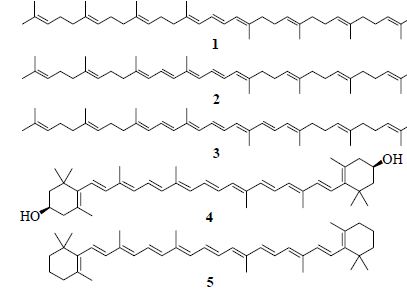 | 图 1 西红花中分离得到的四萜类成分Fig. 1 Tetraterpenes isolated from C. sativus |
2011年,Rubio-Moragaa等[7]从西红花球茎中分离鉴定了2个齐墩果烷型三萜皂苷类化合物azafrine 1(6)和2(7),两者为同分异构体,仅3位取代基的构型存在差异(图 2)。
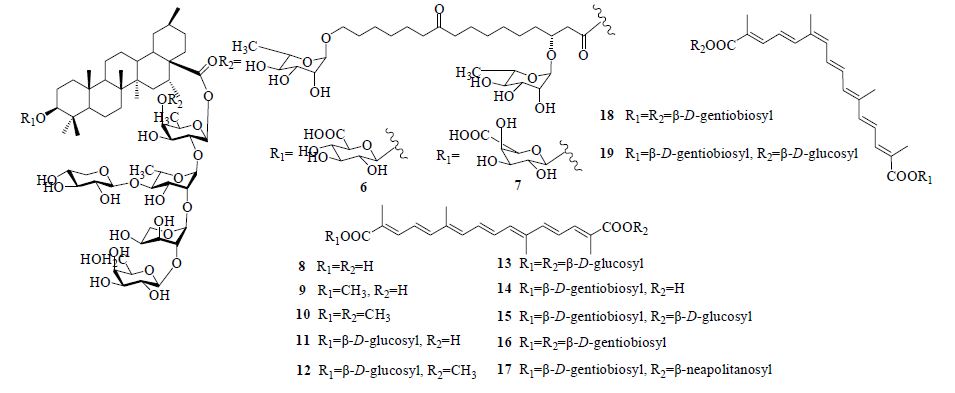 | 图 2 西红花中分离得到的三萜和二萜类成分Fig. 2 Triterpenes and diterpenes isolated from C. sativus |
二萜类是西红花中量最高的一类化合物,也是其最重要的活性组分之一,目前分离鉴定了12个化合物(图 2),此类化合物为西红花酸的羧基与葡萄糖、龙胆二糖、三葡萄糖的羟基形成酯,因西红花酸上C-13位构型差异,此类化合物具有顺式和反式,其中10个为顺式结构,2个为反式结构,分别为西红花酸(crocetin,8)、crocetin monomethyl ester(9)、dimethylcrocetin(10)、crocetin mono (β-D-glucosyl) ester(11)、crocetin β-D-glucosyl- methyl ester(12)、crocetin di (β-D-glucosyl) ester(13)、crocetin mono (β-D-gentiobiosyl) ester(14)、crocetin β-D-gentiobiosyl-β-D-glucosyl ester(15)、crocetin di (β-D-gentiobiosyl) ester(16)、crocetin (β-gentiobiosyl) (β-neapolitanosyl) ester(17)、13-cis-crocetin di (β-D- gentiobiosyl) ester(18)和13-cis-crocetin β-D- gentiobiosyl-β-D-glucosyl ester(19)[6, 8, 9, 10, 11, 12, 13, 14]。
1.1.4 单萜类目前已分离鉴定了19个环香叶烷型单萜类化学成分(表 1和图 3),西红花苦苷(20)和藏花醛(37)是此类化合物的代表性成分,分别是西红花苦味和香味的物质基础。
| 表 1 西红花中的单萜类化合物 Table 1 Monoterpenes from C. sativus |
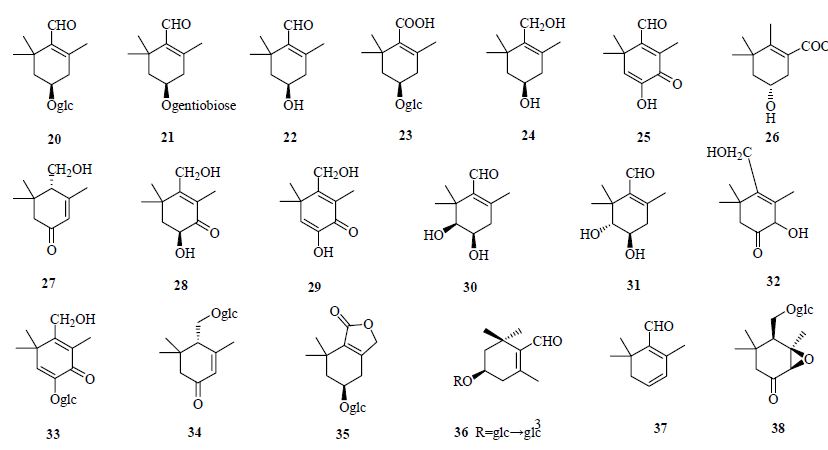 | 图 3 西红花中分离得到的单萜类成分Fig. 3 Monoterpenes isolated from C. sativus |
西红花中的黄酮类成分主要包括黄酮醇及其苷类、黄酮及其苷类,以花瓣中的量最丰富,目前已分离鉴定得到19个化合物(表 2和图 4)。
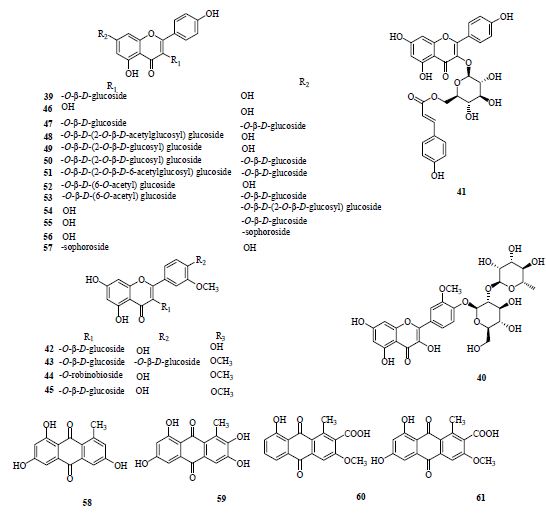 | 图 4 西红花中分离得到的黄酮类及蒽醌类化合物Fig. 4 Flavonoids and anthraquinones isolated from C. sativus |
| 表 2 西红花中的黄酮类化合物 Table 2 Flavonoids from C. sativus |
1999年,高文远等[20]从西红花球茎侧芽中分离鉴定4个蒽醌类化合物(图 4),分别为大黄素(58)、2-羟基大黄素(59)、1-甲基-3-甲氧基-8-羟基蒽醌-2-羧酸(60)和1-甲基-3-甲氧基-6,8-二羟基蒽醌-2-羧酸(61)。
1.4 多取代单苯环类西红花中还含有大量多取代单苯环类化合物,苯环上的氢原子多被-OH、-COOH、-COOCH3等基团取代,有些羟基和羧基进一步和糖分子缩合成苷。目前已经从西红花中分离鉴定17个此类化合物(图 5),分别是Li等[17]和宋纯清等[21]从花粉中分离的1-O-(4-hydroxybenzoyl)-β-D-glucose(62)、4-hydr- oxybenzoic acid(67)、4-hydroxyphenethyl alcohol(68)、benzoic acid(69)、methylparaben(72)、sodium(2S)-(O-hydroxyphenyl) lactate(77)和crosatoside B(71);Li等[8]、Markus等[15]和Gao等[22]从花柱中分离的2-phenylethyl O-β-D-glucopyranoside(65)、benzyl O-β-D-glucopyranoside(70)2,3,4- trihydroxy-6-methoxy-acetophenone-3-β-D-glucoside(63)和2,4-dihydroxy-6-methoxy-acetophenone-2- β-D-glucoside(64);Li等[18]从花瓣中分离得到的3-hydroxy-4-methoxybenzoic acid(66)、4-hydroxy- benzoic acid(67)、methylvanillate(73)、p-coumaric acid(74)、protocatechuic acid(75)、protocatechuic acid methyl ester(76)和vanillic acid(78)。
1.5 环己烷和环己烯衍生物西红花中还含有一些环己烷和环己烯衍生物,在环上多有3个甲基取代基,所以碳原子数一般为9,另外环上的氢原子会被氧化成醇或酮,醇又和糖缩合成苷;有时环上氢原子也会被含3~4个碳原子的烷烃取代,烷烃取代基上的氢原子也会发生氧化、缩合等反应,生成酮、酸或苷类化合物。目前已经从花柱、花粉和花瓣中分离得到此类化合物15个(图 5)[8, 12, 15, 16, 17, 18],分别是 (1R)-3,5,5-trimethylcyclohex-3- enol-O-β-D-glucopyranoside(79)、(2Z)-3-methylpent- 2-enedioic acid-1-[1-(2,4,4-trimethyl-3,6-dioxo- cyclohexenyloxy)-β-D-glucopy-ranoside-6-yl] ester(80)、(4R)-4-(hydroxyl-methyl)-3,5,5-trimethylcyclohex-2- enone-4-β-D-glucoside(81)、(4S)-4-(hydroxyl-methyl)- 3,5,5-trimethylcyclohex-2-enone-4-β-D-glucoside(82)、3,5,5-trimethyl-1,4-cyclohexadion-2-ene(83)、3,5,5-trimethyl-1,4-cyclohexadione(84)、3,5,5-trimethyl- 2-hydroxy-1,4-cyclohexadion-2-en(85)、3,5,5- trimethyl-4-hydroxy-1-cyclohexanon-2-ene(86)、3- hydroxy-β-ionone(87)、crocusatin A(88)、crocusatin E(89)、crocusatin G(90)、crocusatin H(91)、isophorone(92)、(4S,R′)-4-hydroxy-4-(3′-hydroxy- 1′-butenyl)-3,5,5-trimethyl-2-cyclohexen-1-one-3′- O-β-D-glucopyranoside(93)。
1.6 氨基酸及生物碱类西红花还含有少量氨基酸及生物碱类化合物(图 5)[8, 17, 18, 22],如1-(9H-β-carbolin-1-yl)-3,4,5-trihydroxypentan-1-one(94)、5-methyluracil(95)、adenosine(96)、harman(97)、nicotinamide(98)、pyridin-3-yl-methanol(99)、tribulusterine(100)和uracil(101)。
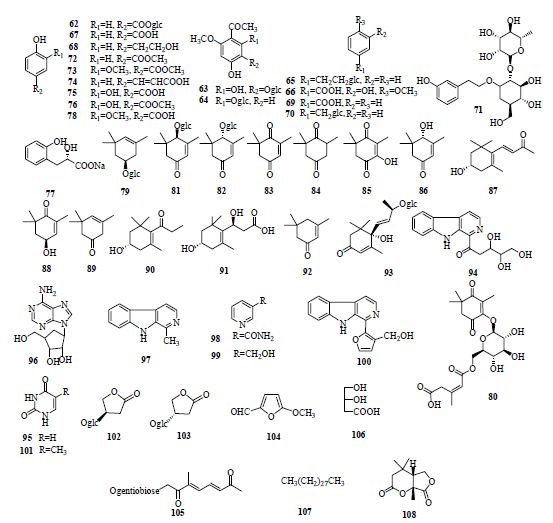 | 图 5 化合物62~108的结构Fig. 5 Chemical structures of compounds 62—108 |
目前,还从西红花中分离得到3个呋喃类化合物(图 5)[8, 15, 22],分别是 (4R)-4-hydroxy dihydrofuran- 2-one-O-β-D-glucopyranoside(102)、(4S)-4-hydroxy- dihydrofuran-2-one-O-β-D-glucopyranoside(103)和2-formyl-5-methoxyfuran(104)。
1.8 其他类此外,还从西红花分离鉴定了(2E,4E)-2-methyl- 6-oxohepta-2,4-dienoic acid β-gentiobiosyl ester(105)、(3S),4-dihydroxybutyric acid(106)、nonacosane(107)和crocusatin F(108)(图 5)[8, 12, 18, 23]。
2 药理活性 2.1 抗精神失常作用《饮腾正要》记载,西红花“主心忧郁积,气闷不散。久食令人心喜”,现代药理学和临床研究也证实其具有抗抑郁、抗焦虑和治疗强迫症的作用。因此,可能成为治疗精神失常类疾病的良药。
2.1.1 抗抑郁Akhondzadeh课题组[24, 25, 26, 27, 28]进行了西红花花柱和花瓣80%乙醇提取物治疗中度和重度抑郁症的临床试验,结果发现连续服药6周后,花柱和花瓣提取物(30 mg/d)的抗抑郁作用均与氟西汀没有显著性差异,说明皆有可能成为氟西汀的替代药物。研究认为,西红花苷-1[29, 30]、藏花醛[30]和山柰酚[31]是其抗抑郁的药效物质基础,不过西红花苷-1和藏花醛在作用机制上不同[30],前者主要通过抑制多巴胺和去甲肾上腺素的再摄取,而藏花醛可能是5-羟色胺(5-HT)再摄取的抑制剂。
此外,Wang等[29]发现西红花球茎的石油醚和二氯甲烷部位也具有抗抑郁作用。
2.1.2 抗焦虑Pitsikas等[32]采用光暗测试法发现西红花苷类的高剂量组(50 mg/kg)具有治疗大鼠焦虑的活性,作用与地西泮(1.5 mg/kg)没有显著性差异,而低剂量组(15、30 mg/kg)没有作用。Hosseinzadeh等[33]则发现西红花水提取物(56、80 mg/kg)和藏花醛(0.15、0.35 mL/kg)都具有抗焦虑作用,但西红花苷类和西红花水提取物中量最高的化合物西红花苷-1却没有作用,以上事实说明西红花抗焦虑作用可能是多种成分协同作用的结果或者在西红花苷类成分中还存在尚未发现的微量活性成分。
2.1.3 治疗强迫症大鼠过度梳理行为被认为是强迫症的表现之一,Georgiadou等[34]建立mCPP引导大鼠过度梳理行为模型,然后ip给药,结果西红花苷(30、50 mg/kg)都能减轻大鼠自我梳理行为,说明其对大鼠强迫症具有治疗作用,由于mCPP是非选择性5-HT受体激动剂,因此认为西红花苷可能是与5-HT能系统的相互作用而发挥疗效。
2.2 治疗经前期综合征(PMS)PMS是指一组反复发生在经前、影响妇女日常生活和工作、涉及躯体和精神两方面的症候群,其严重类型称为经前焦虑症(PMDD)[35]。由于前期研究发现西红花具有抗焦虑作用,因此Agha- Hosseini等[36]认为其也能缓解PMS妇女的精神焦虑状态,并且通过临床试验证实了假说,该研究小组给患者服用2个生理周期的西红花80%醇提取物(30 mg/d),结果在第3、4个生理周期,西红花就显著改善了经期综合症的症状,且无明显副作用。
2.3 治疗神经退行性疾病 2.3.1 帕金森病(PD)PD是锥体外系功能紊乱引起的一种慢性中枢神经系统神经退行性疾病。Ahmad等[37]通过单侧纹状体内注射6-羟基多巴胺(6-OHDA)造成大鼠PD模型,研究西红花活性成分西红花酸治疗PD作用,结果与空白组相比,西红花酸能够提高谷胱甘肽(GSH)、多巴胺量,降低硫代巴比妥酸反应物(TBARs)量,提高抗氧化酶活性,揭示西红花酸可能通过抗氧化作用发挥神经保护作用。
2.3.2 阿尔茨海默病(AD)AD是一种以进行性认知障碍和记忆力损害为主的中枢神经退行性疾病,β淀粉样多肽(Aβ)在脑内的沉淀和聚集是AD的主要致病因素。Ahn等[38]研究发现西红花酸能够抑制Aβ单体聚集成低聚物或纤维,并且能够使已形成的Aβ低聚物或纤维降解,说明西红花酸可用于AD的治疗。
2.4 治疗脑血管疾病 2.4.1 脑梗死颜钫等[39]采用电凝阻断大鼠脑中动脉造成的局灶性脑缺血模型,再将西红花乙醇提取物经十二指肠给药后,发现其能明显缩小脑梗死灶,减轻脑梗死动物的活动行为障碍,同时明显降低脑指数、MDA量,说明西红花对大鼠脑梗死具有明显保护作用。
2.4.2 脑缺血再灌注损伤脑缺血再灌注损伤是指缺血脑组织在恢复血液灌注后,脑组织损伤进一步加重,其发生机制尚未彻底阐明,一般有自由基学说、钙超载学说、兴奋性氨基酸学说、花生四烯酸代谢失衡和白细胞损伤等发生机制[40]。目前已经发现藏花醛、西红花苷-1和西红花酸对脑缺血再灌注损伤都有保护作用。其中藏花醛[41]能够改善脑缺血再灌注引起的氧化应激损伤;西红花苷-1[42, 43]通过抑制脑缺血再灌注损伤引起的氧化/硝化损伤、细胞外调节蛋白激酶(ERK)通路激活和G蛋白偶联受体激酶2(GRK2)移位达到保护作用;而西红花酸[44, 45, 46]对脑血管再灌注损伤的保护作用可能与其抗氧化、降低NO量、增加谷胱甘肽过氧化物酶(GSH-Px)活性,减少caspase-3 mRNA和核转录因子-κB(NF-κB)表达相关。
2.4.3 脑外伤Bie等[47]依据改良神经功能缺损评分表,发现脑外伤大鼠在给予西红花酸72 h后,其能抑制神经细胞凋亡,使血管内皮细胞生长因子受体-2(VEGFR-2)和血清应答因子(SRF)的表达升高,7 d后,其神经系统功能得到显著性恢复。结果表明西红花酸对脑外伤的治疗,早期主要是抑制神经细胞凋亡,亚急性期主要是促进血管生成。
2.5 改善学习记忆障碍多种原因都可能引起学习记忆障碍,如上述提及的AD、脑血管疾病等都可能伴随学习记忆障碍。此外,诸如衰老、酗酒也都可能引起学习记忆障碍,目前,已发现西红花对多种原因引起的学习记忆障碍都有改善作用。
2.5.1 化学物质引起的学习记忆障碍外界长期短暂而高频的输入会引起海马区激发性电位的长时程增强(LTP),这是学习和记忆的细胞学基础,酒精会抑制外界诱导产生的LTP,从而引起学习记忆障碍。Zhang等[48]和Sugiura等[49]首次报道了西红花50%醇提取物通过拮抗对N-甲基-D-天冬氨酸受体(NMDA)的抑制作用[50]达到改善乙醇[49]或乙醛[51]引起的LTP阻碍现象,从而促进小鼠学习记忆恢复。该课题组[52]还研究表明西红花苷-1是西红花中改善学习记忆障碍的主要化学成分,其活性远优于西红花酸龙胆二糖葡萄糖酯,认为龙胆二糖和西红花酸相连的链可能是其活性官能团。但西红花中另一重要化学成分西红花苦苷[53]不具有改善学习记忆障碍的作用。
同样,西红花对其他多种物质如莨菪碱[54]、链霉素[55]、吗啡[56]、D-半乳糖[57]和NaNO2[57]引起的学习记忆障碍也具有改善作用,作用机制可能是通过调节代谢物或酶活性[58],西红花苷-1是其主要活性成分[59, 60]。
2.5.2 衰老引起的学习记忆障碍进入老年之后,由于受到氧化应激和胆碱能功能损伤的影响,大脑将会出现认知下降、记忆缺失等情况。Papandreou等[61]采用ip西红花提取物,发现其能够显著性提高老年大鼠的学习和记忆能力,同时减少脂质过氧化产物,提高大脑总的抗氧化能力和降低caspase-3激活。
2.5.3 血管性痴呆Hosseinzadeh等[62]采用颈总动脉双侧结扎的方法造成大鼠血管性痴呆模型,从而引起大鼠空间记忆损伤,5 d后通过ip西红花苷-1和西红花的80%醇提取物,在7~11 d,采用水迷宫实验研究西红花苷-1和西红花提取物对大鼠空间学习和记忆的影响。结果发现西红花能够改善大脑缺血引起的空间记忆损伤,并推测该结果可能和西红花化学成分的抗氧化活性有关。
2.6 治疗心血管疾病 2.6.1 心肌缺血目前,国内外学者采用注射大剂量异丙肾上腺素(ISO)或冠状动脉结扎法造成大鼠心肌缺血模型研究西红花提取物及其有效成分对心肌缺血的治疗作用,发现西红花水提取物[63, 64, 65]、西红花酸[66, 67, 68, 69]、藏花醛[63]通过ip给药的方式就能改善心肌缺血,作用机制可能与其抗氧化活性和保护心脏功能有关。而关于西红花苷-1 po给药能否治疗心肌缺血疾病还存在一定争议,Goyal等[70]认为口服西红花苷-1能够改善血液动力学和抗氧化酶活性,组织病理学和微观结构的观察也证实了西红花苷-1具有心脏保护作用。但是大部分学者[67, 68, 69, 71]研究发现西红花苷-1通过ip给药并不能改善心肌缺血,需要通过iv给药才能实现治疗目的,说明西红花苷-1 po给药并不能应用于治疗心肌缺血疾病。
2.6.2 心肌缺血再灌注损伤心肌缺血再灌注损伤与能量代谢障碍、细胞内钙超载和自由基的损害作用有非常密切的关系,三者互为因果,导致恶性循环,最终造成心肌细胞死亡。目前,已经采用大鼠心肌缺血再灌注模型研究了西红花酸[72, 73]、藏花醛[74]和西红花苷-1[75]的治疗作用,结果显示三者对大鼠心肌缺血再灌注都有治疗作用,三者可能作用机制分别为西红花酸通过增加缺血区心肌能量物质的量,保护ATP合成酶(ATPase)活性,改善能量代谢障碍;藏花醛主要通过抗氧化及抗凋亡;西红花苷-1主要是通过抗氧化作用。
2.6.3 心肌肥厚心肌肥厚是心脏长期负荷过重的一种适应性反应,以心肌细胞蛋白合成增加和细胞体积增大为主要特征。沈祥春等[76]采用腹主动脉部分狭窄术致大鼠心肌肥厚模型研究西红花酸对心肌肥厚大鼠的治疗作用,发现西红花酸给药1个月后,能显著提高心肌组织的ATPase活力,降低胶原的量,说明其对压力超负荷所致大鼠心肌肥厚具有一定的改善作用。同时发现抑制基质金属蛋白酶(MMPs)的活性可能是其作用机制之一[77]。
2.7 抗动脉粥样硬化目前,关于西红花抗动脉粥样硬化的研究主要集中在西红花酸上,少量报道了西红花苷-1的治疗作用。已经证实西红花酸对动脉粥样硬化的疗效明确,其作用机制主要有以下几种:(1)通过抑制NF-κB激活而减少血管细胞黏附分子-1(VCAM-1)的表达,从而达到治疗动脉粥样硬化的作用[78];(2)改善内皮细胞功能紊乱[79];(3)抗氧化作用[80];(4)上调内皮型NO合酶(eNOS)mRNA表达水平[81];(5)下调低密度脂蛋白受体-1(LOX-1)、植物血凝素样氧化低密度脂蛋白受体-1(LDLOX-1)基因与蛋白的表达水平[82, 83];(6)减少巨噬细胞内胆固醇酯的堆积[84];(7)抗血栓[85]。
此外,He等[86]研究了西红花苷-1对动脉粥样硬化的影响及作用机制,发现西红花苷-1能够抑制鹌鹑动脉粥样硬化的形成,保护血管内皮细胞,减少巨噬细胞中的胆固醇酯,抑制泡沫细胞的形成,抑制平滑肌细胞中[Ca2+]i的升高和降低氧化低密度脂蛋白(Ox-LDL)表达。
2.8 调血脂目前,发现西红花苷-1和西红花酸都具有显著性调血脂作用。由于西红花苷-1口服吸收性差,Lee等[87]、Sheng等[88]和钱之玉等[89]都认为其是通过选择性抑制胰腺酶活性达到调血脂作用的;而西红花酸除了能够抑制胰腺酶之外,其作用机制还可能是抑制内源性胆固醇合成及促进胆固醇向胆汁酸转化及排泄[90];提高血清超氧化物歧化酶(SOD)、谷胱甘肽过氧化物酶(GPX)活性[91];提高脂蛋白脂酶(LPL)表达水平,降低载脂蛋白CIII(apoCIII)水平,加速三酰甘油(TG)消除,达到降低血浆TG的目的[92]。
2.9 抗糖尿病 2.9.1 改善胰岛素抵抗Liang等[93]在2005年首次报道了西红花酸改善胰岛素抵抗作用。该课题组采用低剂量地塞米松引起大鼠的胰岛素抵抗模型,结果血清中胰岛素、游离脂肪酸(FFA)、TG和肿瘤坏死因子-α(TNF-α)都显著性增加;此外,肝糖原量继续增加,胰岛细胞显示出补偿性多动症;而给予西红花酸之后,西红花酸能够改善地塞米松引起的所用副作用,说明西红花酸能够阻止地塞米松引起的胰岛素抵抗。Yang等[94]采用棕榈酸酯引起的3T3-L1脂肪细胞胰岛素抵抗研究了西红花酸的作用机制,认为其可能为通过抑制蛋白激酶Cθ(PKCθ)磷酸化达到抑制c-Jun N端蛋白激酶(JNK)和核转录因子κB抑制蛋白激酶β(IKKβ)的激活,从而改善棕榈酸酯引起的3T3-L1脂肪细胞的胰岛素抵抗。
2.9.2 降血糖Mohajeri等[95]发现西红花醇提取物能够降低正常大鼠血糖,并对胰腺有保护作用。Kianbakht等[96]则认为西红花苷-1、西红花酸和藏花醛可能是其降血糖的药效物质基础。Kang等[97]研究了西红花降血糖的作用机制,认为腺苷酸活化蛋白激酶(AMPK)在葡萄糖吸收和胰岛素敏感度方面发挥重要作用。
2.10 其他此外,还发现西红花具有降血压[98]、抗菌[99, 100]、消炎止痛[101, 102, 103]、抗癌[104, 105]、抗氧化[106, 107]、美白[108]、抗肺纤维化[109]、抗肾纤维化[110]和治疗胃溃疡[111, 112, 113]、视网膜病变[114, 115, 116, 117]、脂肪肝[118, 119, 120]、癫痫[121, 122]、惊厥[123, 124]等作用。
3 展望西红花作为活血化瘀类中药,在心脑血管疾病方面的药用价值明确,国内也将西红花中的活性组分西红花苷类成分开发成药物,可用于胸痹心痛,心血阻症,症见胸痛、胸闷、憋气、心悸、舌紫暗或有瘀点、瘀班。不过西红花化学成分复杂,药理活性多样,并且不断被发现新的药理作用,如抗癌、美白、治疗视网膜病变和脂肪肝等,是一味值得深入研究与开发的中药。
在研究过程中,需要重视西红花的药效物质筛选,解决目前仅将研究重点集中在西红花苷-1、西红花酸、西红花苦苷、藏花醛等少数几种成分上,忽视了其他新化合物的活性评价以及先导化合物构效关系研究等问题;需要重视西红花治疗疾病的作用机制研究,明确活性成分的作用通路和靶点,为进一步筛选西红花活性成分,开发具有科学价值和市场影响力的产品奠定基础。
由于西红花主要活性成分不稳定,如西红花苷类的长链不饱和烃结构易被氧化断裂、西红花苦苷的苷键会被水解而藏花醛易挥发,因此,在西红花相关产品开发过程中,需要加强西红花活性成分的稳定性保护研究,并选择合适的制剂成型技术,使产品质量稳定,保证临床用药的安全和有效。
| [1] | 中国药典 [S]. 一部. 2010. |
| [2] | 饶君凤, 王根法, 吕伟德. 浙江省西红花"二段法"优质高产栽培技术研究 [J]. 安徽农业科学, 2012, 40(9): 5214-5215. |
| [3] | Yilmaz A, Nyberg N T, Mølgaard P, et al. 1H-NMR metabolic fingerprinting of saffron extracts [J]. Metabolomics, 2010, 6: 511-517. |
| [4] | 王加真, 徐学文, 宋义富, 等. 氮肥施用量对西红花产量的影响 [J]. 中国园艺文摘, 2010(1): 11-12. |
| [5] | Basker D, Negbi M. Uses of saffron [J]. Economic Bot, 1983, 37(2): 228-236. |
| [6] | Pfander H, Schurtenberger H. Biosynthesis of C20-carotenoids in Crocus sativus [J]. Phytochemistry, 1982, 21(5): 1039-1042. |
| [7] | Rubio-Moragaa Á, Gerwigb G J, Castro-Díaz N, et al. Triterpenoid saponins from corms of Crocus sativus: Localization, extraction and characterization [J]. Ind Crops Prod, 2011, 34: 1401-1409. |
| [8] | Li C Y, Wu T S. Constituents of the stigmas of Crocus sativus and their tyrosinase inhibitory activity [J]. J Nat Prod, 2002, 65: 1452-1456. |
| [9] | Tarantilis P A, Beljebbar A, Manfait M, et al. FT-IR, FT-Raman spectroscopic study of carotenoids from saffron (Crocus sativus L.) and some derivatives [J]. Spectrochim Acta Part A, 1998, 54: 651-657. |
| [10] | Van Calsteren M R, Bissonnette M C, Cormier F, et al. Spectroscopic characterization of crocetin derivatives from Crocus sativus and Gardenia jasminoides [J]. J Agric Food Chem, 1997, 45: 1055-1061. |
| [11] | Tung N H, Shoyama Y. New minor glycoside components from saffron [J]. J Nat Med, 2013, 67: 672-676. |
| [12] | Straubinger M, Jezussek M, Waibel R, et al. Novel glycosidic constituents from saffron [J]. J Agric Food Chem, 1997, 45: 1678-1681. |
| [13] | 周素娣, 周锦祥. 国产西红花化学成分的研究 [J]. 中草药, 1997, 28(12): 715-716 |
| [14] | Pfister S, Meyer P, Steck A, et al. Isolation and structure elucidation of carotenoid-glycosyl esters in gardenia fruits (Gardenia jasminoides Ellis) and saffron (Crocus sativus Linn.) [J]. J Agric Food Chem, 1996, 44(9): 2612-2615. |
| [15] | Straubinger M, Bau B, Eckstein S, et al. Identification of novel glycosidic aroma precursors in saffron (Crocus sativus L.) [J]. J Agric Food Chem, 1998, 46(8): 3238-3243. |
| [16] | Zarghami N S, Heinz D E. Monoterpene aldehydes and isophorone-related compounds of saffron [J]. Phytochemistry, 1971, 10: 2755-2761. |
| [17] | Li C Y, Wu T S. Constituents of the pollen of Crocus sativus L. and their tyrosinase inhibitory activity [J]. Chem Pharm Bull, 2003, 50: 1305-1309. |
| [18] | Li C Y, Lee E J, Wu T S. Antityrosinase principles and constituents of the petals of Crocus sativus [J]. J Nat Prod, 2004, 67: 437-440. |
| [19] | 宋纯清, 徐任生. 番红花化学成分研究II. 番红花花被中的黄酮醇类化合物 [J]. 中草药, 1990, 21(10): 7-9. |
| [20] | 高文运, 李, 朱大元, 番红花侧芽中的新蒽醌化合物 [J]. 植物学报, 1999, 41(5): 531-533. |
| [21] | 宋纯清, 徐任生. 番红花化学成分研究III. 番红花花粉中的番红花新苷甲和乙的结构 [J]. 化学学报, 1991, 49(9): 917-920. |
| [22] | Gao W Y, Li Y M, Zhu D Y. Phenolic glucosides and a γ-lactone glucoside from the sprouts of Crocus sativus [J]. Planta Med, 1999, 65(5): 425-427. |
| [23] | 宋纯清, 徐任生, 黄哲夫. 番红花花被化学成分研究 [J]. 中药材, 1985, 8(4): 17-19. |
| [24] | Akhondzadeh S, Fallah-Pour H, Afkhaml K, et al. Comparison of Crocus sativus L. and imipramine in the treatment of mild to moderate depression: a pilot double-blind randomized trial [J]. BMC Complem Alternat Med, 2004, doi: 10. 1186/1472-6882-4-12. |
| [25] | Akhondzadeh S, Tahmacebi-Pour N, Noorbalal A A, et al. Crocus sativus L. in the treatment of mild to moderate depression: A double-blind, randomized and placebo-controlled trial [J]. Phytother Res, 2005, 19(2): 148-151. |
| [26] | Noorbala A A, Akhondzadeh S, Tahmacebi-Pour N, et al. Hydro-alcoholic extract of Crocus sativus L. versus fluoxetine in the treatment of mild to moderate depression: a double-blind, randomized pilot trial [J]. J Ethnopharmacol, 2005, 97(2): 281-284. |
| [27] | Moshiri E, Basti A A, Noorbala A A, et al. Crocus sativus L. (petal) in the treatment of mild-to-moderate depression: A double-blind, randomized and placebo-controlled trial [J]. Phytomedicine, 2006, 13: 607-611. |
| [28] | Akhondzadeh B A, Ghoreishi S A, Noorbala A A, et al. Petal and stigma of Crocus sativus L. in the treatment of depression: A pilot double-blind randomized trial [J]. J Med Plants, 2008, 7(4): 29-36. |
| [29] | Wang Y, Han T, Zhu Y, et al. Antidepressant properties of bioactive fractions from the extract of Crocus sativus L [J]. J Nat Med, 2010, 64(1): 24-30. |
| [30] | Hosseinzadeh H, Karimi G, Niapoor M, et al. Antidepressant effect of Crocus sativus L. stigma extracts and their constituents, crocin and safranal, in mice [J]. Proceed Int Symp Saffron Biol Biotechnol, 2004, 650: 435-445. |
| [31] | Hosseinzadeh H, Motamedshariaty V, Hadizadeh F. Antidepressant effect of kaempferol, a constituent of saffron (Crocus sativus) petal, in mice and rats [J]. Pharmacologyonline, 2007, 2: 367-370. |
| [32] | Pitsikasa N, Boultadakisa A, Georgiadou G, et al. Effects of the active constituents of Crocus sativus L., crocins, in an animal model of anxiety [J]. Phytomedicine, 2008, 15(12): 1135-1139. |
| [33] | Hosseinzadeh H, Noraei N B. Anxiolytic and hypnotic effect of Crocus sativus aqueous extract and its constituents, crocin and safranal, in mice [J]. Phytother Res, 2009, 23(6): 768-774. |
| [34] | Georgiadou G, Tarantilis P A, Pitsikas N. Effects of the active constituents of Crocus sativus L., crocins, in an animal model of obsessive-compulsive disorder [J]. Neurosci Lett, 2012, 528(1): 27-30. |
| [35] | 曹缵孙, 陈晓燕. 妇产科综合征 [M]. 北京: 人民卫生出版社, 2003. |
| [36] | Agha-Hosseini M, Kashani L, Aleyaseen A, et al. Crocus sativus L. (saffron) in the treatment of premenstrual syndrome: a double-blind, randomised and placebo- controlled trial [J]. Bjogan Int J Obst Gynaecol, 2008, 115(4): 515-519. |
| [37] | Ahmad A S, Ansari M A, Ahmad M, et al. Neuroprotection by crocetin in a hemi-parkinsonian rat model [J]. Pharmacol Biochem Behavior, 2005, 81(4): 805-813. |
| [38] | Ahn J H, Hu Y, Hernandez M, et al. Crocetin inhibits beta-amyloid fibrillization and stabilizes beta-amyloid oligomers [J]. Biochem Biophysic Res Commun, 2011, 414(1): 79-83. |
| [39] | 颜 钫, 唐 琳, 陈 放. 西红花甙对缺血性脑梗塞的药效研究 [J]. 四川大学学报: 自然科学版, 2000, 37(1): 107-109. |
| [40] | 胡伟东, 胡耀祖, 黄小平. 中药有效成分对脑缺血再灌注损伤保护作用的研究进展 [J]. 实用心脑肺血管病杂志, 2010, 18(1): 92-95. |
| [41] | Hosseinzadeh H, Sadeghnia H R. Safranal, a constituent of Crocus sativus (saffron), attenuated cerebral ischemia induced oxidative damage in rat hippocampus [J]. J Pharm Pharmacol, 2005, 8(3): 394-399. |
| [42] | Zheng Y Q, Liu X J , Wang J N, et al. Effects of crocin on reperfusion-induced oxidative nitrative injury to cerebral microvessels after global cerebral ischemia [J]. Brain Res, 2007, 1138: 86-94. |
| [43] | Vakili A, Einali M R, Bandegi A R. Protective effect of Crocin against cerebral ischemia in a dose-dependent manner in a rat model of ischemic stroke [J]. J Stroke Cerebrov Dis, 2014, 23(1): 106-113. |
| [44] | 谭安雄, 朱耀斌, 王玉银. 西红花酸对大鼠脑缺血-再灌注氧自由基及一氧化氮的影响 [J]. 医药导报, 2011, 30(7): 846-848. |
| [45] | 谭安雄, 李小云. 西红花酸对大鼠脑缺血再灌注Caspase-3 mRNA和NF-κB表达的影响 [J]. 中国医院药学杂志, 2012, 32(1): 8-11. |
| [46] | 皋 聪, 彭飞城, 钱之玉. 西红花酸对小鼠脑缺血再灌注损伤的保护作用 [J]. 中国临床药理学与治疗学, 2009, 14(4): 421-425. |
| [47] | Bie X D, Chen Y Q, Zheng X S, et al. The role of crocetin in protection following cerebral contusion and in the enhancement of angiogenesis in rats [J]. Fitoterapia, 2011, 82(7): 997-1002. |
| [48] | Zhang Y X, Shoyama Y, Sugiura M, et al. Effects of Crocus sativus L. on the ethanol-induced impairment of passive avoidance performance in mice [J]. Biol Pharm Bull, 1994, 17: 217-221. |
| [49] | Sugiura M, Saito H, Abe K. Ethanol extract of Crocus sativus L. antagonizes the inhibitory action of ethanol on hippocampal long-term potentiation in vivo [J]. Phytother Res, 1995, 9(2): 100-104. |
| [50] | Abe K, Sugiura M, Shoyama Y, et al. Crocin antagonizes ethanol inhibition of NMDA receptor-mediated responses in rat hippocampal neurons [J]. Brain Res, 1998, 787(1): 132-138. |
| [51] | Abe K, Sugiura M, Shoyama Y, et al. Saffron extract prevents acetaldehyde-induced inhibition of long-term potentiation in the rat dentate gyrus in vivo [J]. Brain Res, 1999, 851: 287-289. |
| [52] | Sugiura M, Shoyama Y, Saito H, et al. Crocin (crocetin digentiobiose ester) prevents the inhibitory effect of ethanol on long-term potentiation in the dentate gyrus in vivo [J]. J Pharmacol Exp Therap, 1994, 271: 703-707. |
| [53] | Sugiura M, Shoyama Y, Saito H, et al. Crocin improves the ethanol-induced impairment of learning behaviors of mice in passive avoidance tasks [J]. Proceed Jap Acad Series B-Physic Biol Sci, 1995, 71(10): 319-324. |
| [54] | Pitsikas N, Sakellaridis N. Crocus sativus L. extracts antagonize memory impairments in different behavioural tasks in the rat [J]. Behavioural Brain Res, 2006, 173(1): 112-115. |
| [55] | Khalili M, Roghani M, Ekhlasi M. The effect of aqueous Crocus sativus L. extract on intracerebroventricular streptozotocin-induced cognitive deficits in rat: a behavioral analysis [J]. Iranian J Pharm Res, 2010, 8(3): 185-191. |
| [56] | Naghibi S M, Hosseini M, Khani F, et al. Effect of aqueous extract of Crocus sativus L. on morphine-induced memory impairment [J]. Adv Pharmacol Sci, 2012. doi: 10.1155/2012/494367. |
| [57] | Dashti M H, Zeinali F, Anvari M, et al. Saffron (Crocus sativus L.) extract prevents and improves D-galactose and nano (2) induced memory impairment in mice [J]. Excli J, 2012, 11: 328-337. |
| [58] | Khalili M, Kiasalari Z, Rahmati B, et al. Behavioral and histological analysis of Crocus sativus effect in intracerebroventricular streptozotocin model of Alzheimer disease in rats [J]. Iranian J Pathol, 2010, 5(1): 27-33. |
| [59] | Pitsikas N, Zisopoulou S, Tarantilis P A, et al. Effects of the active constituents of Crocus sativus L., crocins on recognition and spatial rats' memory [J]. Behavioural Brain Res, 2007, 183(2): 141-146. |
| [60] | Khalili M, Hamzeh F. Effects of active constituents of Crocus sativus L., crocin on streptozocin-induced model of sporadic Alzheimer's disease in male rats [J]. Iranian Biomed J, 2010, 14: 59-65. |
| [61] | Papandreou M A, Tsachaki M, Efthimiopoulos S, et al. Memory enhancing effects of saffron in aged mice are correlated with antioxidant protection [J]. Behav Brain Res, 2011, 219(2): 197-204. |
| [62] | Hosseinzadeh H, Sadeghnia H R, Ghaeni F A, et al. Effects of Saffron (Crocus sativus L.) and its active constituent, crocin, on recognition and spatial memory after chronic cerebral hypoperfusion in rats [J]. Phytother Res, 2012, 26(3): 381-386. |
| [63] | Mehdizadeh R, Parizadeh M R, Khooei A R, et al. Cardioprotective effect of saffron extract and safranal in isoproterenol-induced myocardial infarction in wistar rats [J]. Iranian J Basic Med Sci, 2013, 16(1): 56-63. |
| [64] | Sachdeva J, Tanwar V, Golechha M, et al. Crocus sativus L. (saffron) attenuates isoproterenol-induced myocardial injury via preserving cardiac functions and strengthening antioxidant defense system [J]. Exp Toxicol Pathol, 2012, 64(6): 557-564. |
| [65] | Joukar S, Najafipour H, Khaksari M, et al. The effect of saffron consumption on biochemical and histopathological heart Indices of rats with myocardial infarction [J]. Cardiov Toxicol, 2010, 10(1): 66-71. |
| [66] | 刘同征, 钱之玉. 西红花酸对异丙肾上腺素致大鼠急性心肌缺血损伤的保护作用 [J]. 中草药, 2003, 34(5): 439-442. |
| [67] | 韩潇媛, 钱之玉, 张 荣, 等. 比较西红花酸和西红花苷对异丙肾上腺素损伤心肌的作用 [J]. 药学与临床研究, 2009, 17(3): 177-181. |
| [68] | Zhang R, Qian Z Y, Han X Y, et al. Comparison of the effects of crocetin and crocin on myocardial injury in rats [J]. Chin J Nat Med, 2009, 7(3): 223-227. |
| [69] | 张 荣, 钱之玉, 韩潇媛, 等. 西红花酸和西红花苷对缺血缺氧损伤心肌保护作用的比较研究 [J]. 中国天然药物, 2009, 7(3): 223-227. |
| [70] | Goyal S N, Arora S, Sharma A K, et al. Preventive effect of crocin of Crocus sativus on hemodynamic, biochemical, histopathological and ultrastuctural alterations in isoproterenol-induced cardiotoxicity in rats [J]. Phytomedicine, 2010, 17: 227-232. |
| [71] | 杜 鹏, 钱之玉, 沈祥春, 等. 西红花苷对大鼠心肌损伤的影响 [J]. 中国新药杂志, 2005, 14(12): 1423-1427. |
| [72] | 文 娜, 钱之玉, 饶淑云, 等. 西红花酸对大鼠心肌缺血再灌注损伤能量代谢的影响 [J]. 中国新药杂志, 2005, 14(12): 1294-1297. |
| [73] | 寇鑫晖, 钱之玉. 西红花酸对大鼠心肌缺血再灌注损伤的保护作用 [J]. 中草药, 2008, 39(7): 1049-1053. |
| [74] | Bharti S, Golechha M, Kumari S, et al. Akt/GSK-3 β/eNOS phosphorylation arbitrates safranal-induced myocardial protection against ischemia-reperfusion injury in rats [J]. Eur J Nutr, 2012, 51(6): 719-727. |
| [75] | Jahanbakhsh Z, Rasoulian B, Jafari M, et al. protective effect of crocin against reperfusion-induced cardiac arrhythmias in anaesthetized rats [J]. Excli J, 2012, 11: 20-29. |
| [76] | 沈祥春, 钱之玉. 西红花酸对压力超负荷致心肌肥厚大鼠的ATPase及胶原的影响 [J]. 中草药, 2003, 34(6): 534-537. |
| [77] | 沈祥春, 钱之玉. 西红花酸对压力超负荷所致大鼠心肌肥厚的影响 [J]. 药学学报, 2004, 39(3): 172-175. |
| [78] | Zheng S G, Qian Z Y, Tang F T, et al. Suppression of vascular cell adhesion molecule-1 expression by crocetin contributes to attenuation of atherosclerosis in hypercholesterolemic rabbits [J]. Biochem Pharmacol, 2005, 70(8): 1192-1199. |
| [79] | Tang F T, Qian Z Y, Liu P Q, et al. Crocetin improves endothelium-dependent relaxation of thoracic aorta in hypercholesterolemic rabbit by increasing eNOS activity [J]. Biochem Pharmacol, 2006, 72(5): 558-565. |
| [80] | He S Y, Qian Z Y, Wen N, et al. Influence of crocetin on experimental atherosclerosis in hyperlipidamic-diet quails [J]. Eur J Pharmacol, 2007, 554: 191-195. |
| [81] | 唐富天, 钱之玉, 郑书国. 西红花酸对动脉粥样硬化鹌鹑血清一氧化氮含量的影响及其机制 [J]. 中国天然药物, 2005, 3(5): 316-320. |
| [82] | 蔡恒玲, 刘应辉, 刘娜娜. 西红花酸对动脉粥样硬化大鼠血脂及LOX-1表达的影响 [J]. 中国现代医药杂志, 2011, 13(10): 3-5. |
| [83] | 蔡恒玲, 唐双阳, 周 娟, 等. 西红花酸下调动脉粥样硬化大鼠LDLOX-1的表达 [J]. 中国热带医学, 2012, 12(1): 12-14. |
| [84] | 邓远雄, 钱之玉, 何丽华, 等. 西红花酸对巨噬细胞源性泡沫细胞形成的影响 [J]. 中国中药杂志, 2011, 36(10): 1374-1377. |
| [85] | 徐沁蕾, 钱之玉. 西红花酸抗凝血和抗血栓形成作用的实验研究 [J]. 中草药, 2007, 38(1): 89-91. |
| [86] | He S Y, Qian Z Y, Tang F T, et al. Effect of crocin on experimental atherosclerosis in quails and its mechanisms [J]. Life Sci, 2005, 77(8): 907-921. |
| [87] | Lee I A, Lee J H, Baek N I, et al. Antihyperlipidemic effect of crocin isolated from the fructus of Gardenia jasminoides and its metabolite crocetin [J]. Biol Pharm Bull, 2005, 28(11): 2106-2110. |
| [88] | Sheng L, Qian Z Y, Zheng S G, et al. Mechanism of hypolipidemic effect of crocin in rats: Crocin inhibits pancreatic lipase [J]. Eur J Pharmacol, 2006, 543(1/3): 116-122. |
| [89] | 钱之玉, 西红花苷调血脂作用机制研究 [J]. 中国执业药师, 2009, 6(2): 10-16. |
| [90] | 赵博华, 钱之玉, 陈 真, 等. 西红花酸对大鼠血浆胆固醇的调节作用及其机制研究 [J]. 中国新药杂志, 2009, 18(14): 1347-1351. |
| [91] | 郑书国, 钱之玉, 王宏婷. 西红花酸对高脂血症家兔LDL氧化易感性及血清Ox-LDL水平的影响 [J]. 中国实验方剂学杂志, 2009, 15(6): 50-53. |
| [92] | 盛亮, 钱之玉, 季 晖. 西红花酸改善大鼠高三酰甘油血症的作用机制 [J]. 中国新药杂志, 2008, 17(21): 1843-1847. |
| [93] | Xi L, Qian Z Y, Shen X C, et al. Crocetin prevents dexamethasone-induced insulin resistance in rats [J]. Planta Med, 2005, 71(10): 917-922. |
| [94] | Yang L, Qian Z Y, Ji H, et al. Inhibitory effect on protein kinase C by Crocetin attenuates palmitate-induced insulin insensitivity in 3T3-L1 adipocytes [J]. Eur J Pharmacol, 2010, 642: 47-55. |
| [95] | Mohajeri D, Tabrizi B A, Mousavi G, et al. Anti-diabetic activity of Crocus sativus L. (saffron) stigma ethanolic extract in alloxan-induced diabetic rats [J]. Res J Biol Sci, 2008, 3(9): 1102-1108. |
| [96] | Kianbakht S, Hajiaghaee R. Anti-hyperglycemic effects of saffron and its active constituents, crocin and safranal, in alloxan-induced diabetic rats [J]. J Med Plants, 2011, 10(39): 82-89. |
| [97] | Kang C K, Lee H K, Jung E S, et al. Saffron (Crocus sativus L.) increases glucose uptake and insulin sensitivity in muscle cells via multipathway mechanisms [J]. Food Chem, 2012, 135(4): 2350-2358. |
| [98] | Imenshahidi M, Hosseinzadeh H, Javadpour Y. Hypotensive effect of aqueous saffron extract (Crocus sativus L.) and its constituents, safranal and crocin, in normotensive and hypertensive rats [J]. Phytother Res, 2010, 24(7): 990-994. |
| [99] | Nakhaei M, Khajeh K A M, Ramezani M. Inhibition of Helicobacter pylori growth in vitro by saffron (Crocus sativus L.) [J]. Iranian J Basic Med Sci, 2008, 11(2): 91-96. |
| [100] | Pintado C, de Miguel A, Acevedo O, et al. Bactericidal effect of saffron (Crocus sativus L.) on salmonella enterica during storage [J]. Food Control, 2011, 22: 638-642. |
| [101] | Hosseinzadeh H, Younesi H M. Antinociceptive and anti-inflammatory effects of Crocus sativus L. stigma and petal extracts in mice [J]. BMC Pharmacol, 2002. http:// www. biomedcentral. com/1471-2210/2/7. |
| [102] | Hosseinzadeh H, Shariaty V M. Anti-nociceptive effect of safranal, a constituent of Crocus sativus (saffron), in mice [J]. Pharmacologyonline, 2007, 2: 498-503. |
| [103] | Xu G L, Li G, Ma H P, et al. Preventive effect of crocin in inflamed animals and in LPS-challenged RAW 264. 7 cells [J]. J Agric Food Chem, 2009, 57(18): 8325-8330. |
| [104] | Amin A, Hamza A A, Bajbouj K, et al. Saffron: A potential candidate for a novel anticancer drug against hepatocellular carcinoma [J]. Hepatology, 2011, 54(3): 857-867. |
| [105] | Mancini A, Lizzi A, Simone D, et al. Saffron extract and its major cons a tituent crocin selectively inhibit the growth of human prostate cancer cell in vitro and in vivo [J]. Eur J Cancer, 2012, 48: S113. |
| [106] | 陈 阳, 杨 婷, 黄 娟, 等. 西红花苷和西红花酸在小鼠体内抗氧化活性对比研究 [J]. 中国药理学通报, 2010, 26(2): 248-251. |
| [107] | 龚国清, 刘同征, 李立文, 等. 西红花酸的体外抗氧化作用的研究 [J]. 中国药科大学学报, 2001, 32(4): 306-309. |
| [108] | Vyas L K, Tapar K K, Nema R K. Study of Crocus sativus as complexion promoter in skin care [J]. Int J Pharma Clin Res, 2010, 2: 76-79. |
| [109] | 成文媛, 钱之玉, 杨丽娜, 等. 西红花酸在AngⅡ诱导的大鼠肺成纤维细胞中的作用 [J]. 药学与临床研究, 2012, 20(2): 103-108. |
| [110] | 周忠启. 西红花酸对单侧输尿管大鼠肾组织结缔组织生长因子表达的影响 [J]. 牡丹江医学院学报, 2008, 29(4): 34-36. |
| [111] | Al-Mofleh L A, Alhaider A A, Mossa J S, et al. Antigastric ulcer studies on saffron Crocus sativus L. in rats [J]. Pakistan J Biol Sci, 2006, 9(6): 1009-1013. |
| [112] | Nabavizadeh F, Salimi E, Sadroleslami Z, et al. Saffron (Crocus sativus) increases gastric acid and pepsin secretions in rats: Role of nitric oxide (NO) [J]. African J Pharm Pharmacol, 2009, 3(5): 181-184. |
| [113] | Kianbakht S, Mozaffari K. Effects of saffron and its active constituents, crocin and safranal, on prevention of indomethacin induced gastric ulcers in diabetic and nondiabetic rats [J]. J Med Plants, 2009, 8: 30-38. |
| [114] | Xuan B, Zhou Y H, Li N, et al. Effects of crocin analogs on ocular blood flow and retinal function [J]. J Ocular Pharmacol Therap, 1999, 15(2): 143-152. |
| [115] | Laabich A, Vissvesvaran G P, Lieu K L, et al. Protective effect of crocin against blue light-and white light-mediated photoreceptor cell death in bovine and primate retinal primary cell culture [J]. Investig Ophthalmol Visual Sci, 2006, 47(7): 3156-3163. |
| [116] | Maccarone R, Marco S D, Bisti S. Saffron supplement maintains morphology and function after exposure to damaging light in mammalian retina [J]. Investig Ophthalmol Visual Sci, 2008, 49(3): 1254-1261. |
| [117] | Yamauchi M, Tsuruma K, Imai S, et al. Crocetin prevents retinal degeneration induced by oxidative and endoplasmic reticulum stresses via inhibition of caspase activity [J]. Eur J Pharmacol, 2011, 650(1): 110-119. |
| [118] | Mohajeri D, Nazeri M. Inhibitory effect of crocin on hepatic steatosis in the rats fed with high fat diet [J]. J Animal Veteriny Adv, 2012, 11(14): 2373-2379. |
| [119] | 廖中强, 胡梦瑶, 王 静, 等. 西红花酸抗氧化干预脂肪肝细胞的研究 [J]. 营养学报, 2011, 33(2): 167-171. |
| [120] | 施 韵, 盛 亮, 钱之玉, 等. 西红花酸对大鼠酒精性脂肪肝的改善作用及机制探讨 [J]. 中国新药杂志, 2008, 17(24): 2115-2118. |
| [121] | Tamaddonfard E, Gooshchi N H, Seiednejad-Yamchi S. Central effect of crocin on penicillin-induced epileptiform activity in rats [J]. Pharmacol Rep, 2012, 64: 94-101. |
| [122] | Hosseinzadeh H, Sadeghnia H R. Protective effect of safranal on pentylenetetrazol-induced seizures in the rat Involvement of GABAergic and opioids systems [J]. Phytomedicine, 2007, 14: 256-262. |
| [123] | Hosseinzadeh H, Khosravan V. Anticonvulsant effects of aqueous and ethanolic extracts of Crocus sativus L. stigmas in mice [J]. Archiv Iranian Med, 2002, 5(1): 44-47. |
| [124] | Hosseinzadeh H, Talebzadeh F. Anticonvulsant evaluation of safranal and crocin from Crocus sativus in mice [J]. Fitoterapia, 2006, 76: 722-724. |
 2014, Vol. 45
2014, Vol. 45

